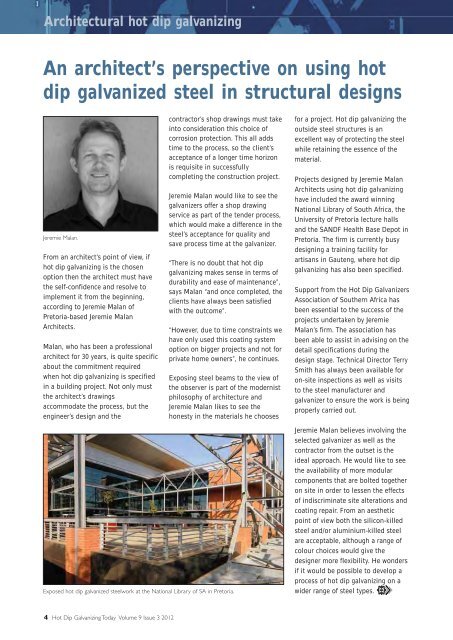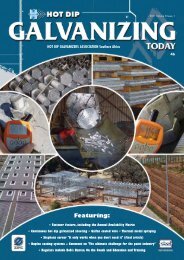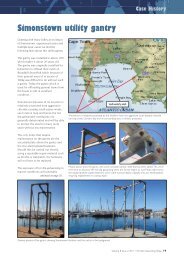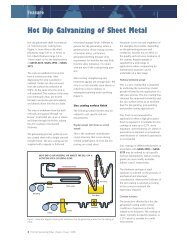Architectural hot dip galvanizing - hdgasa
Architectural hot dip galvanizing - hdgasa
Architectural hot dip galvanizing - hdgasa
You also want an ePaper? Increase the reach of your titles
YUMPU automatically turns print PDFs into web optimized ePapers that Google loves.
<strong>Architectural</strong> <strong>hot</strong> <strong>dip</strong> <strong>galvanizing</strong><br />
An architect’s perspective on using <strong>hot</strong><br />
<strong>dip</strong> galvanized steel in structural designs<br />
Jeremie Malan.<br />
From an architect’s point of view, if<br />
<strong>hot</strong> <strong>dip</strong> <strong>galvanizing</strong> is the chosen<br />
option then the architect must have<br />
the self-confidence and resolve to<br />
implement it from the beginning,<br />
according to Jeremie Malan of<br />
Pretoria-based Jeremie Malan<br />
Architects.<br />
Malan, who has been a professional<br />
architect for 30 years, is quite specific<br />
about the commitment required<br />
when <strong>hot</strong> <strong>dip</strong> <strong>galvanizing</strong> is specified<br />
in a building project. Not only must<br />
the architect’s drawings<br />
accommodate the process, but the<br />
engineer’s design and the<br />
contractor’s shop drawings must take<br />
into consideration this choice of<br />
corrosion protection. This all adds<br />
time to the process, so the client’s<br />
acceptance of a longer time horizon<br />
is requisite in successfully<br />
completing the construction project.<br />
Jeremie Malan would like to see the<br />
galvanizers offer a shop drawing<br />
service as part of the tender process,<br />
which would make a difference in the<br />
steel’s acceptance for quality and<br />
save process time at the galvanizer.<br />
“There is no doubt that <strong>hot</strong> <strong>dip</strong><br />
<strong>galvanizing</strong> makes sense in terms of<br />
durability and ease of maintenance”,<br />
says Malan “and once completed, the<br />
clients have always been satisfied<br />
with the outcome”.<br />
“However, due to time constraints we<br />
have only used this coating system<br />
option on bigger projects and not for<br />
private home owners”, he continues.<br />
Exposing steel beams to the view of<br />
the observer is part of the modernist<br />
philosophy of architecture and<br />
Jeremie Malan likes to see the<br />
honesty in the materials he chooses<br />
for a project. Hot <strong>dip</strong> <strong>galvanizing</strong> the<br />
outside steel structures is an<br />
excellent way of protecting the steel<br />
while retaining the essence of the<br />
material.<br />
Projects designed by Jeremie Malan<br />
Architects using <strong>hot</strong> <strong>dip</strong> <strong>galvanizing</strong><br />
have included the award winning<br />
National Library of South Africa, the<br />
University of Pretoria lecture halls<br />
and the SANDF Health Base Depot in<br />
Pretoria. The firm is currently busy<br />
designing a training facility for<br />
artisans in Gauteng, where <strong>hot</strong> <strong>dip</strong><br />
<strong>galvanizing</strong> has also been specified.<br />
Support from the Hot Dip Galvanizers<br />
Association of Southern Africa has<br />
been essential to the success of the<br />
projects undertaken by Jeremie<br />
Malan’s firm. The association has<br />
been able to assist in advising on the<br />
detail specifications during the<br />
design stage. Technical Director Terry<br />
Smith has always been available for<br />
on-site inspections as well as visits<br />
to the steel manufacturer and<br />
galvanizer to ensure the work is being<br />
properly carried out.<br />
Exposed <strong>hot</strong> <strong>dip</strong> galvanized steelwork at the National Library of SA in Pretoria.<br />
Jeremie Malan believes involving the<br />
selected galvanizer as well as the<br />
contractor from the outset is the<br />
ideal approach. He would like to see<br />
the availability of more modular<br />
components that are bolted together<br />
on site in order to lessen the effects<br />
of indiscriminate site alterations and<br />
coating repair. From an aesthetic<br />
point of view both the silicon-killed<br />
steel and/or aluminium-killed steel<br />
are acceptable, although a range of<br />
colour choices would give the<br />
designer more flexibility. He wonders<br />
if it would be possible to develop a<br />
process of <strong>hot</strong> <strong>dip</strong> <strong>galvanizing</strong> on a<br />
wider range of steel types.<br />
4 Hot Dip Galvanizing Today Volume 9 Issue 3 2012

















